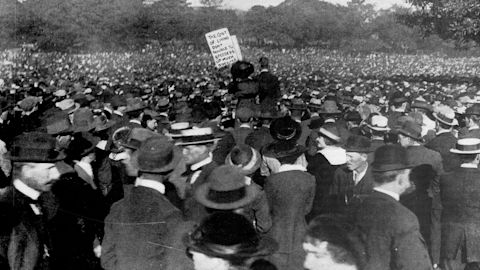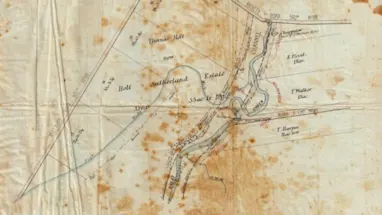
The year 2017 marked the centenary of the Great Strike of 1917, one of Australia’s largest industrial disputes. It took place against the backdrop of World War I and the conscription debates. This was an era of unprecedented social and political upheaval, exacerbated by the war, changing social values and world events including the Russian revolution.
The strike started when almost 6,000 employees from the Eveleigh Railway Workshops and Randwick Tramsheds walked off the job. The strike was in response to a new way of monitoring worker productivity known as the timecard system.
Soon an estimated 77,350 people from workplaces across NSW went on strike.

More than 100,000 men, women and children marched through the streets of Sydney to The Domain in weekly social protests.
Quickly the strike led to limited public transport, power blackouts and food shortages.
While 77,000 went on strike, almost 7,000 came to Sydney to ‘break the strike’

On the other side of the political divide, striking during wartime was considered unpatriotic and disloyal. Around 7,000 middle-class professionals, farmers and university students attempted to break the strike by doing the jobs of the strikers.

Several hundred teenage boys from private schools also heeded the call. They were referred to as volunteer labour or scabs, depending on allegiances. Many volunteered at Eveleigh Railway Workshops. For over 3 weeks, they worked as cleaners and ‘hands’ in the machine and erecting shops, cleaned locomotive engines in the running sheds, and served food to other volunteers.
Voices from Sydney’s past tell different sides of the Great Strike

Bernie Johnston was a young boy living in Surry Hills in 1917. When interviewed 70 years later, he remembered the strike as: “a bitter thing because it divided the working class completely.”
Bill White, a tram driver at Rozelle Depot in the 1920s, recalled the strike and its aftermath as: “a terrible time of victimisation and abuse and hatred, jingoism and patriotism…”

Hazel Walker was studying at Sydney University when she volunteered to help break the strike. She remembers the male engineering students ran the trains, while female students, including herself, worked in the railway refreshment rooms: “We as students thought it was great fun, doing something different.”
Hear the voices of the people who lived through the great strike.
Remembering the strike
The nationwide strike lasted just 6 weeks, but its consequences endured for those involved, dividing loyalties and shaping political consciousness. It created a highly politicised workforce from which a generation of politicians would later emerge.
Despite these legacies, this event is not widely remembered. It was considered by many to be a defeat for the labour movement, and the action was subsequently overshadowed by the memory of war and the conscription debates.



